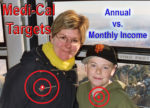No one at Covered California calls the IRS for information and the IRS does not send Covered California any of your information. No one at Covered California will ever see your federal tax return unless you provide it to them.

Kevin Knauss: Health, History, Travel, Insurance


The income columns that have been updated to reflect the higher federal poverty levels are 138%, 213%, 266%, and 322%. All those income columns, based on household size, correspond to Medi-Cal eligibility for adults, Medi-Cal for Pregnant Women, Medi-Cal for Children, and Medi-Cal Assess Program and CCHIP for children in counties in San Francisco, San Mateo, and Santa Clara counties. The other income columns that are not tied to Medi-Cal eligibility remain unchanged from the 2023 open enrollment period.

By


Because Medi-Cal workers don’t understand or comprehend some of these sources of income, they terminate the Covered California enrollments of adults and children. This creates chaos for these families. An unknown, uninvited, and unauthorized individual accesses a Covered California application and makes an uneducated determination of the household’s income. Then this same elusive individual terminates coverage for individuals and families, some of them undergoing health care treatment with specific providers not in any Medi-Cal HMO network.


The subsidy benefit for families burdened with crippling employer group health insurance premiums can be enormous. Unfortunately, acquiring the necessary employer information and calculating the affordability percentage can be daunting for some families. However, Covered California has created some worksheets and tools to help in the process.


In this particular case, the user ID of System-CW-San Diego alerted us that a case worker at San Diego County Medi-Cal had reviewed the application. I cannot say that the case worker changed the tax filing status. There are instances when the Medi-Cal system does not properly mesh with the Covered California CalHEERS software. There are times when conditional information is just erased or changed because of an incompatibility with the data fields.

Effective January 1, 2023, a new California law expands the definition of “dependent” for the purposes of enrollment in a Qualified Health Plan (QHP), to include a parent or stepparent of a qualified consumer. Rules for this benefit include that a dependent parent or stepparent must:


Where households realize a dramatic increase in Blue Shield PPO Covered California premiums is when the SLCSP has a small increase or negative rate change. Consumers in regions 2, 3, 4, 6, 7, 15, 16 and 18, where the SLCSP rate increases were in the low single digits will see a smaller subsidy. In other words, the Blue Shield PPO plan rate increases in those areas was greater than the SLCSP that the subsidy is based upon. The subsidy did not keep pace with the Blue Shield PPO rate increase like they did in regions 1 and 10.


Many people do not update their income every year. While the income stays static, the threshold for Medi-Cal creeps up. The 2022 federal poverty levels are being applied for the 2023 Covered California subsidy and Medi-Cal eligibility. Many families are being caught by surprise that their current income is too low to maintain subsidies for their children.


People mistakenly believe that their past federal income tax return is used for their future income estimate. The past tax return can be a guide to estimating the income, but it is not final determination. One problem with federal tax returns is they usually don’t capture Social Security retirement benefits or tax-exempt interest, both of which are included in the Modified Adjusted Gross Income.

Spam prevention powered by Akismet